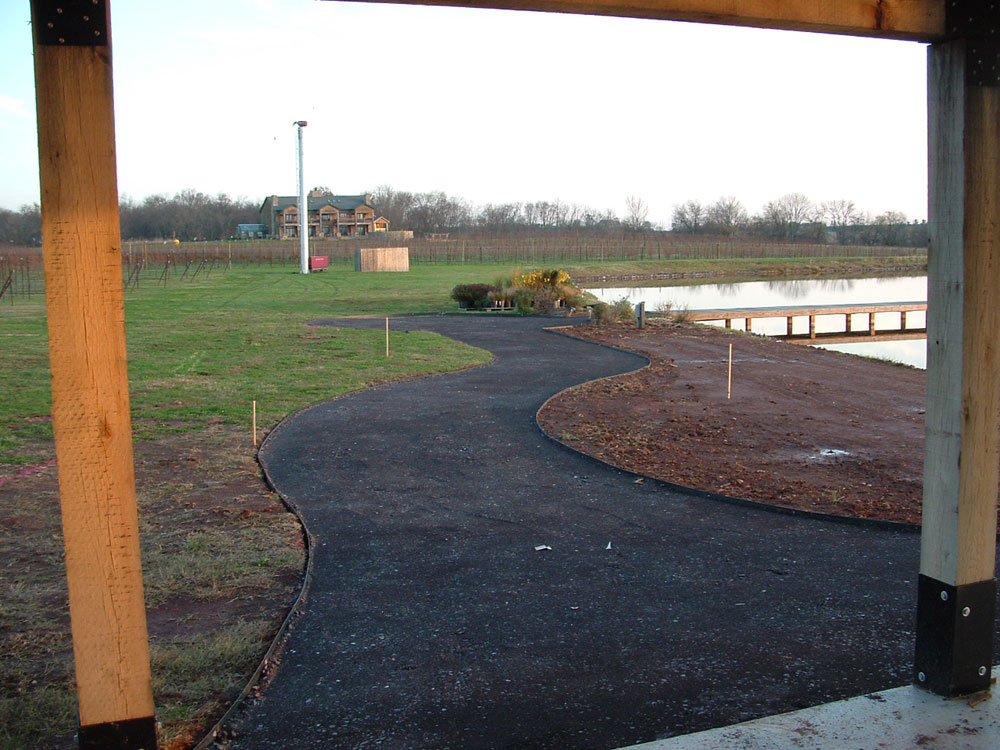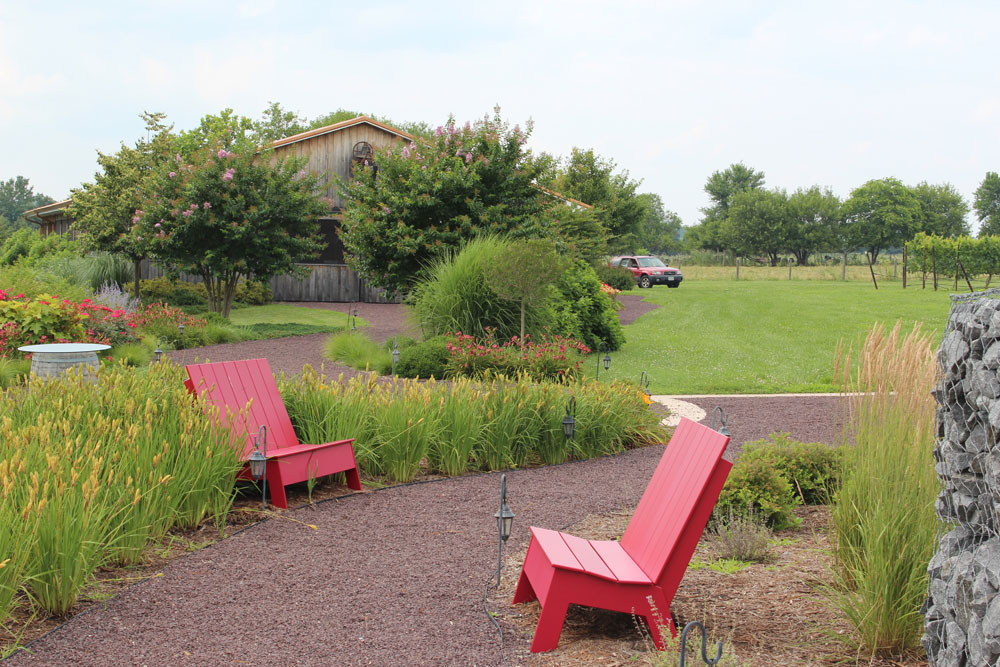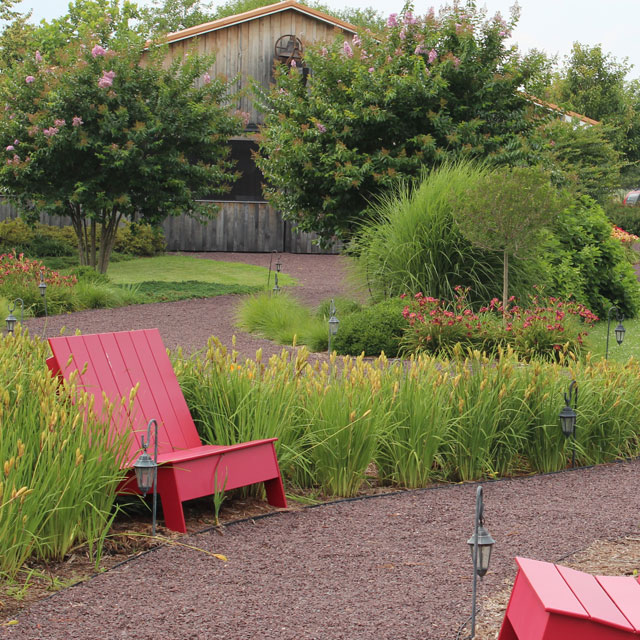There’s a certain appeal to gravel paths and patios. They somehow manage to at once be both casual and formally elegant. A gravel path says “let’s go somewhere, and you don’t need a tie to get there.” The thing is, a gravel path can be downright awful if not installed properly. Gravel can spill out and mix with adjacent grass and mulch. Weeds can overrun the gravel. Most importantly, a gravel path can be darn difficult to walk on if not constructed properly. If you’ve dismissed the idea of a gravel path because the last one you were on, it was like walking through the dunes at the beach – that was one bad apple. Here’s how to build a gravel path the right way.

Step One – Excavation
You can’t just dump a few wheelbarrows of gravel on the ground and call it a day. When we do a gravel path for a client project we dig down 4-6 inches. That lets us eliminate the sod and/or plant matter in the top few inches, and it allows us to create a cleanly defined shape for the path.
Step Two – The Prep
Once the path is excavated out, we run a plate compactor over the soil to give us a solid sub-base. We then cover the bottom with a woven geotextile fabric to keep the soil and the base layer separate – just like you would when starting a paver walk. For the sides, we usually recommend some sort of edging to keep the gravel separated from adjacent lawn areas or plant beds. Granite cobblestones are gorgeous but pricy; powdercoated aluminum edging is attractive yet unobtrusive and reasonably priced. I don’t love the plastic edging sold at the box stores as it never seems to hold up well and it does a lousy job of holding a true radius curve.
Step Three – The Base Layer
Do you know why a poorly installed pea gravel path (or patio, or driveway) feels like you’re slogging through beach sand? It’s because a lot of people have zero clue how to build a gravel path. Pea gravel is rounded and doesn’t interlock, so you really are moving the full depth of the path with every step. Even if we’re using an angular stone like ⅜” chip gravel (#8 stone) I still like to use a solid base.

For this base layer we use 21A (aka ¾” minus, aka ABC stone, aka crusher run). We spread it evenly, then run a plate compactor over it. This process is repeated until we’re within an inch to an inch and a half of the desired path height. The goal is to have a compacted, rock solid base you could run a car over.
Step Four – The Pretty Stuff
We finish off the pathway with our decorative stone of choice. That can be pea gravel, #8 stone, or whatever works for the look you’re trying to achieve. If we’re using an angular stone like ⅜” chip gravel (#8) and it’s going to be a high traffic area, we’ll run the compactor over it a few times. We don’t use the compactor with pea gravel because a rounded stone won’t compact or interlock. May as well try teaching the dog ballet for all the good it’ll do.

And that’s it! Yes, doing all this does make the process take longer, but you now have a rock solid gravel path that is easy to walk on and way less likely to have any sort of weed issues. Trust me, it’s totally worth it – now you know exactly how to build a gravel path. To see more of this project, check out the Culpeper Winery Landscape Design page!


This is in UK – but we make great gravel paths by just laying gravel with dust included. (dust being the clay dust they clean off at the quarry. You can buy it separately or included – you need to specify. Sometimes called hoggin)
Two inches depth of this stuff laid over grass – path made. Weeds seed into it a little. Not much. Weathers down to rock hard surface. Xxxxx
Anne, sounds like what you use is similar to our 21a, aka 3/4″ minus, that we use for this. What locks everything in is the range of particles from 3/4″ stone to dust.
What about the epoxy on top of the gravel? A Contractor told us about it when discussing a gravel patio but I’m not finding anything online about it
Hi Lisa, it’s a really neat product. Not sure if your contractor gave you specific brands, but two to look at are Gravel Lok and Klingstone Paths. We haven’t used them yet, but we’ve seen plenty of installs in the field (for example, James Madison’s Montpelier estate used it to make the front gravel path ADA compliant). Hope that helps!
So I’m a person that didn’t do it the right way. When I built the path I simply laid a 3-4″ layer of pea gravel on top of some DG ( I did tamp down the DG, somewhat). but I didn’t lay down any base layer of rock. I noticed pretty quickly the hand tamper did nothing to strengthen the walkway.
It’s mainly cosmetic vs a functional pathway, but wondering if there’s anything I can do to make it a bit more sturdy. I was actually about to rent a compactor and get more gravel, and glad I didn’t after reading this. I’m guessing the best bet would be to pull out the pea gravel, lay some base rock and basically start over. it’s just going to end up being a lot of rock to move a few times. Any other tips for strengthening it up without starting over?
Hey Ryan, the only way I can see to not have to pull up the pea gravel and do it right would be to use a binder resin like Gravel Lok or Klingstone Path. Those lock everything together, and it’s actually strong enough that it creates an ADA approved surface.
I dont know if this site is still active but great information- Im in Calif- Very wet winters, dry summers- I have several acres which I want to do gravel paths on, about 10′ wide-very occasional car vehicle traffic like an atv,bobcat or truck to deliver hay-otherwise I’ll just be riding my horses on these so top layer of gravel must be small- some of the paths are sloped so im thinking on steeper areas of doing a grid underneath and adding gravel trenches horizontally about every 10-15 feet in areas that get very wet during our rainy season. on top of that,compact. then do the 21A,compact then do the smaller gravel .
So how many inches of 21 A should I do? Can the top layer be granite fines or what?? has to be small for the sake of my horses feet , good drainage is critical- thank so much for any help -there is literally no one to ask these questions of here.
Hi Bonnie, 21A isn’t going to be a great choice for a free-draining base as it compacts super tight. Given the stormwater conditions you’re trying to address, there are two local resources that should be able to help. One is if you google where you are + soil and water conservation district. I did that with San Diego just to see, since I used to live there, and there is an office. The folks in that office are great at stormwater management AND helping to find the right design for driveways, paths, etc. My local district officers helped us design a private road across some challenging soil conditions.
You can also look on your city or county government website under environmental services. There is usually a stormwater management division.
Both of these resources are free, at least out east. They’re going to be your best resources for local conditions. I hope this helps!
Well, no doubt it makes a great path, but whew! a lot of work. Where could I best cut corners here (compromise on perfection) in order to get a functional, solid path way. Need to make a 2 foot wide path for about 40 feet up to a cabin, on a slight incline.
I am in the process of installing a gravel walkway along the lines of what you feature in your very helpful article. Where I live, in the Chicago suburbs, it is very flat and we can have heavy rains at times, which ends up flooding our backyard (and sometimes our basement). My question is whether the woven geotextile fabric would still allow for drainage to occur or if it would inhibit it. In my research, I noticed that there is also nonwoven geotextile fabric, which is more permeable (but might not be as defined a barrier between the dirt and the aggregate. I took your advice to Bonnie and wrote to my stormwater management department in our local village, but I am curious to hear what you would suggest.